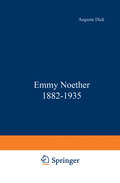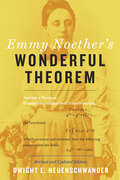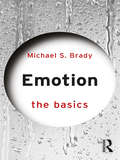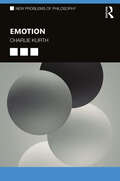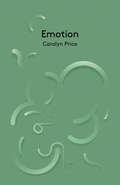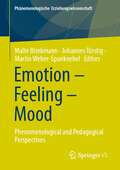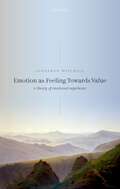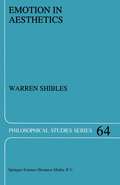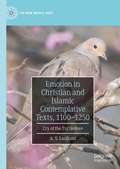- Table View
- List View
Emmanuel Levinas and the Limits to Ethics: A Critique and a Re-Appropriation (Routledge Jewish Studies Series)
by Aryeh BotwinickEmanuel Levinas and the Limits to Ethics highlights how radically different Jewish ethics is from Christian ethics, and the profound affinities that subsist between Jewish ethics and philosophical and political liberalism. The philosophy of Emmanuel Levinas has captured the imagination of a global constituency who take his absolutizing of ethical demands and his assigning primacy to ethics over all other branches of inquiry in his mapping of Western philosophy to be indicative of a major re-ordering of both personal and cultural identity. It is this re-ordering, they believe, that would restore greater wholeness and value to human life. In this book, Aryeh Botwinick takes issue with both the theoretical analysis that Levinas engages in, and the practical ethical import that he draws from it. Arguing that what Levinas has to say about both skepticism and negative theology can be used to re-route his argument away from the avowed aims of his thought, this book will be of great interest to students and scholars of Jewish Studies, Ethics and Philosophy.
Emmanuel Levinas's Talmudic Turn: Philosophy and Jewish Thought (Cultural Memory in the Present)
by Ethan KleinbergIn this rich intellectual history of the French-Jewish philosopher Emmanuel Levinas's Talmudic lectures in Paris, Ethan Kleinberg addresses Levinas's Jewish life and its relation to his philosophical writings while making an argument for the role and importance of Levinas's Talmudic lessons. Pairing each chapter with a related Talmudic lecture, Kleinberg uses the distinction Levinas presents between "God on Our Side" and "God on God's Side" to provide two discrete and at times conflicting approaches to Levinas's Talmudic readings. One is historically situated and argued from "our side" while the other uses Levinas's Talmudic readings themselves to approach the issues as timeless and derived from "God on God's own side." Bringing the two approaches together, Kleinberg asks whether the ethical message and moral urgency of Levinas's Talmudic lectures can be extended beyond the texts and beliefs of a chosen people, religion, or even the seemingly primary unit of the self. Touching on Western philosophy, French Enlightenment universalism, and the Lithuanian Talmudic tradition, Kleinberg provides readers with a boundary-pushing investigation into the origins, influences, and causes of Levinas's turn to and use of Talmud.
Emmy Noether – Mathematician Extraordinaire
by David E. RoweAlthough she was famous as the "mother of modern algebra," Emmy Noether’s life and work have never been the subject of an authoritative scientific biography. Emmy Noether – Mathematician Extraordinaire represents the most comprehensive study of this singularly important mathematician to date. Focusing on key turning points, it aims to provide an overall interpretation of Noether’s intellectual development while offering a new assessment of her role in transforming the mathematics of the twentieth century.Hermann Weyl, her colleague before both fled to the United States in 1933, fully recognized that Noether’s dynamic school was the very heart and soul of the famous Göttingen community. Beyond her immediate circle of students, Emmy Noether’s lectures and seminars drew talented mathematicians from all over the world. Four of the most important were B.L. van der Waerden, Pavel Alexandrov, Helmut Hasse, and Olga Taussky. Noether’s classic papers on ideal theory inspired van der Waerden to recast his research in algebraic geometry. Her lectures on group theory motivated Alexandrov to develop links between point set topology and combinatorial methods. Noether’s vision for a new approach to algebraic number theory gave Hasse the impetus to pursue a line of research that led to the Brauer–Hasse–Noether Theorem, whereas her abstract style clashed with Taussky’s approach to classical class field theory during a difficult time when both were trying to find their footing in a foreign country.Although similar to Proving It Her Way: Emmy Noether, a Life in Mathematics, this lengthier study addresses mathematically minded readers. Thus, it presents a detailed analysis of Emmy Noether’s work with Hilbert and Klein on mathematical problems connected with Einstein’s theory of relativity. These efforts culminated with her famous paper "Invariant Variational Problems," published one year before she joined the Göttingen faculty in 1919.
Emmy Noether 1882–1935
by DICKN 1964 at the World's Fair in New York I City one room was dedicated solely to mathematics. The display included a very at tractive and informative mural, about 13 feet long, sponsored by one of the largest com puter manufacturing companies and present ing a brief survey of the history of mathemat ics. Entitled, "Men of Modern Mathematics," it gives an outline of the development of that science from approximately 1000 B. C. to the year of the exhibition. The first centuries of this time span are illustrated by pictures from the history of art and, in particular, architec ture; the period since 1500 is illuminated by portraits of mathematicians, including brief descriptions of their lives and professional achievements. Close to eighty portraits are crowded into a space of about fourteen square feet; among them, only one is of a woman. Her face-mature, intelligent, neither pretty nor handsome-may suggest her love of sci- 1 Emmy Noether ence and creative gift, but certainly reveals a likeable personality and a genuine kindness of heart. It is the portrait of Emmy Noether ( 1882 - 1935), surrounded by the likenesses of such famous men as Joseph Liouville (1809-1882), Georg Cantor (1845-1918), and David Hilbert (1862 -1943). It is accom panied by the following text: Emmy Noether, daughter of the mathemati cian Max, was often called "Der Noether," as if she were a man.
Emmy Noether's Wonderful Theorem
by Dwight E. Neuenschwander"In the judgment of the most competent living mathematicians, Fräulein Noether was the most significant creative mathematical genius thus far produced since the higher education of women began."â€�Albert EinsteinThe year was 1915, and the young mathematician Emmy Noether had just settled into Göttingen University when Albert Einstein visited to lecture on his nearly finished general theory of relativity. Two leading mathematicians of the day, David Hilbert and Felix Klein, dug into the new theory with gusto, but had difficulty reconciling it with what was known about the conservation of energy. Knowing of her expertise in invariance theory, they requested Noether’s help. To solve the problem, she developed a novel theorem, applicable across all of physics, which relates conservation laws to continuous symmetriesâ€�one of the most important pieces of mathematical reasoning ever developed.Noether’s "first" and "second" theorem was published in 1918. The first theorem relates symmetries under global spacetime transformations to the conservation of energy and momentum, and symmetry under global gauge transformations to charge conservation. In continuum mechanics and field theories, these conservation laws are expressed as equations of continuity. The second theorem, an extension of the first, allows transformations with local gauge invariance, and the equations of continuity acquire the covariant derivative characteristic of coupled matter-field systems. General relativity, it turns out, exhibits local gauge invariance. Noether’s theorem also laid the foundation for later generations to apply local gauge invariance to theories of elementary particle interactions. In Dwight E. Neuenschwander’s new edition of Emmy Noether’s Wonderful Theorem, readers will encounter an updated explanation of Noether’s "first" theorem. The discussion of local gauge invariance has been expanded into a detailed presentation of the motivation, proof, and applications of the "second" theorem, including Noether’s resolution of concerns about general relativity. Other refinements in the new edition include an enlarged biography of Emmy Noether’s life and work, parallels drawn between the present approach and Noether’s original 1918 paper, and a summary of the logic behind Noether’s theorem.
Emmy Noether's Wonderful Theorem
by Dwight E. Neuenschwander"In the judgment of the most competent living mathematicians, Fräulein Noether was the most significant creative mathematical genius thus far produced since the higher education of women began."â€�Albert EinsteinThe year was 1915, and the young mathematician Emmy Noether had just settled into Göttingen University when Albert Einstein visited to lecture on his nearly finished general theory of relativity. Two leading mathematicians of the day, David Hilbert and Felix Klein, dug into the new theory with gusto, but had difficulty reconciling it with what was known about the conservation of energy. Knowing of her expertise in invariance theory, they requested Noether’s help. To solve the problem, she developed a novel theorem, applicable across all of physics, which relates conservation laws to continuous symmetriesâ€�one of the most important pieces of mathematical reasoning ever developed.Noether’s "first" and "second" theorem was published in 1918. The first theorem relates symmetries under global spacetime transformations to the conservation of energy and momentum, and symmetry under global gauge transformations to charge conservation. In continuum mechanics and field theories, these conservation laws are expressed as equations of continuity. The second theorem, an extension of the first, allows transformations with local gauge invariance, and the equations of continuity acquire the covariant derivative characteristic of coupled matter-field systems. General relativity, it turns out, exhibits local gauge invariance. Noether’s theorem also laid the foundation for later generations to apply local gauge invariance to theories of elementary particle interactions. In Dwight E. Neuenschwander’s new edition of Emmy Noether’s Wonderful Theorem, readers will encounter an updated explanation of Noether’s "first" theorem. The discussion of local gauge invariance has been expanded into a detailed presentation of the motivation, proof, and applications of the "second" theorem, including Noether’s resolution of concerns about general relativity. Other refinements in the new edition include an enlarged biography of Emmy Noether’s life and work, parallels drawn between the present approach and Noether’s original 1918 paper, and a summary of the logic behind Noether’s theorem.
Emotion: The Basics (The Basics)
by Michael BradyWhile human beings might be rational animals, they are emotional animals as well. Emotions play a central role in all areas of our lives and if we are to have a proper understanding of human life and activity, we ought to have a good grasp of the emotions. Michael S. Brady structures Emotion: The Basics around two basic, yet fundamental, questions: What are emotions? And what do emotions do? In answering these questions Brady provides insight into a core component of all our lives, covering: the nature of emotion; emotion, knowledge, and understanding; emotion and action; emotions and social groups; emotion, morality, and art. In this concise and insightful introduction, Brady explains why we are often better off as a result of emotion rather than reason being in the driving seat, as our lives, both individual and social, would be significantly impoverished without the emotions. With a glossary of key terms and suggestions for further reading, Emotion: The Basics is an ideal starting point for anyone seeking a full introduction to the philosophical study of emotion.
Emotion (New Problems of Philosophy)
by Charlie KurthEmotions have long been of interest to philosophers and have deep historical roots going back to the Ancients. They have also become one of the most exciting areas of current research in philosophy, the cognitive sciences, and beyond. In this book, Charlie Kurth explains the philosophy of the emotions, structuring the book around seven fundamental questions: What are emotions? Are emotions natural kinds? Do animals have emotions? Are emotions epistemically valuable? Are emotions the foundation for value and morality? Are emotions the basis for responsibility? Do emotions make us better people? In the course of exploring these questions, he also discusses cutting-edge empirical research on emotion, feminist approaches to emotions and their value, and methodological questions on how to theorize about the emotions. The book also contains in-depth discussions of specific emotions like compassion, disgust, anxiety, and curiosity. It also highlights emerging trends in emotion research. Including suggestions for further reading and a glossary of key terms, Emotion is ideal for those studying and researching the philosophy of emotion as well as ethics, epistemology, and the philosophies of mind and psychology.
Emotion (New Problems of Philosophy)
by Charlie KurthEmotions have long been of interest to philosophers and have deep historical roots going back to the Ancients. They have also become one of the most exciting areas of current research in philosophy, the cognitive sciences, and beyond. In this book, Charlie Kurth explains the philosophy of the emotions, structuring the book around seven fundamental questions: What are emotions? Are emotions natural kinds? Do animals have emotions? Are emotions epistemically valuable? Are emotions the foundation for value and morality? Are emotions the basis for responsibility? Do emotions make us better people? In the course of exploring these questions, he also discusses cutting-edge empirical research on emotion, feminist approaches to emotions and their value, and methodological questions on how to theorize about the emotions. The book also contains in-depth discussions of specific emotions like compassion, disgust, anxiety, and curiosity. It also highlights emerging trends in emotion research. Including suggestions for further reading and a glossary of key terms, Emotion is ideal for those studying and researching the philosophy of emotion as well as ethics, epistemology, and the philosophies of mind and psychology.
Emotion (Key Concepts in Philosophy)
by Carolyn PriceEmotion is at the centre of our personal and social lives. To love or to hate, to be frightened or grateful is not just a matter of how we feel on the inside: our emotional responses direct our thoughts and actions, unleash our imaginations, and structure our relationships with others. Yet the role of emotion in human life has long been disputed. Is emotion reason?s friend or its foe? From where do the emotions really arise? Why do we need them at all? In this accessible and carefully argued introduction, Carolyn Price focuses on some central questions about the nature and function of emotion. She explores the ways in which emotion contrasts with belief and considers how our emotional responses relate to our values, our likes and our needs. And she investigates some of the different ways in which emotional responses can be judged as fitting or misplaced, rational or irrational, authentic or inauthentic, sentimental or profound. Throughout, she develops a particular view of emotion as a complex and diverse phenomenon, which reflects both our common evolutionary past and our different cultural and personal histories. Engagingly written with lots of examples to illuminate our understanding, this book provides the ideal introduction to the topic for students and scholars and anyone interested in delving further into the intricate web of human emotion.
Emotion – Feeling – Mood: Phenomenological and Pedagogical Perspectives (Phänomenologische Erziehungswissenschaft #12)
by Malte Brinkmann Johannes Türstig Martin Weber-SpanknebelThis volume provides systematic, interdisciplinary, and intercultural impulses for a phenomenological pedagogy of emotions, feelings, and moods without subordinating them to the logocentric dualism of emotion and rationality. Starting from foundational and cultural perspectives on pedagogical relations of education, learning, and Bildung, specific emotions in individual studies, as well as different approaches of important representatives of phenomenological research on emotions are presented. The contributions include pedagogical, philosophical, and empirical approaches to feelings, emotions, and moods, highlighting their fundamental importance and productivity for learning, Bildung, and education in different pedagogical institutions and fields.
Emotion and Imagination
by Adam MortonRecent years have seen an enormous amount of philosophical research into the emotions and the imagination, but as yet little work has been done to connect the two. In his engaging and highly original new book, Adam Morton shows that all emotions require some form of imagination and goes on to fully explore the link between these two important concepts both within philosophy and in everyday life.We may take it for granted that complex emotions, such as hope and resentment, require a rich thinking and an engagement with the imagination, but Morton shows how more basic and responsive emotions such as fear and anger also require us to take account of possibilities and opportunities beyond the immediate situation. Interweaving a powerful tapestry of subtle argument with vivid detail, the book highlights that many emotions, more than we tend to suppose, require us to imagine a situation from a particular point of view and that this in itself can be the source of further emotional feeling. Morton goes on to demonstrate the important role that emotions play in our moral lives, throwing light on emotions such as self-respect, disapproval, and remorse, and the price we pay for having them. He explores the intricate nature of moral emotions and the challenges we face when integrating our thinking on morality and the emotions. This compelling and thought-provoking new book challenges many assumptions about the nature of emotion and imagination and will appeal to anyone seeking a deeper understanding of the role that these concepts play in our lives. The book also has far reaching implications that will spark debate amongst scholars and students for some time to come.
Emotion and Imagination
by Adam MortonRecent years have seen an enormous amount of philosophical research into the emotions and the imagination, but as yet little work has been done to connect the two. In his engaging and highly original new book, Adam Morton shows that all emotions require some form of imagination and goes on to fully explore the link between these two important concepts both within philosophy and in everyday life.We may take it for granted that complex emotions, such as hope and resentment, require a rich thinking and an engagement with the imagination, but Morton shows how more basic and responsive emotions such as fear and anger also require us to take account of possibilities and opportunities beyond the immediate situation. Interweaving a powerful tapestry of subtle argument with vivid detail, the book highlights that many emotions, more than we tend to suppose, require us to imagine a situation from a particular point of view and that this in itself can be the source of further emotional feeling. Morton goes on to demonstrate the important role that emotions play in our moral lives, throwing light on emotions such as self-respect, disapproval, and remorse, and the price we pay for having them. He explores the intricate nature of moral emotions and the challenges we face when integrating our thinking on morality and the emotions. This compelling and thought-provoking new book challenges many assumptions about the nature of emotion and imagination and will appeal to anyone seeking a deeper understanding of the role that these concepts play in our lives. The book also has far reaching implications that will spark debate amongst scholars and students for some time to come.
Emotion and the Arts
by Mette Hjort Sue LaverThe only work of its kind, this exciting collection assembles a number of analytically minded philosophers, psychologists, and literary theorists, all of whom seek to provide fine-grained accounts of critical problems having to do with emotion and art. How best to explain emotions produced by works of art? What goes on when we feel emotion for an abstract art such as music? How is it that we can intelligibly feel emotion for persons and situations that we know are fictional? What is involved in our empathic experience of negative emotion through the art of tragedy? A strongly interdisciplinary volume that captures the richness of current debates about the role of agency in human emotional response, this collection also considers the influence of culture on emotion and demonstrates that cognitivist and social- constructivist perspectives need not be antagonistic and may actually work together in a complementary way. Essays cluster under four rubrics--"The Paradox of Fiction", "Emotion and its Expression through Art", "The Rationality of Emotional Responses to Art", and "The Value of Emotion"--and together they address questions of emotion in film, painting, music, dance, literature, and theater. With new work by leading thinkers in the field of aesthetics, and drawing upon state of the art scholarship from areas such as cognitive science, literary studies, and contemporary ethics, Emotion and the Arts is essential reading for those who study aesthetics, literature, theories of emotion, and the mind.
Emotion and Value
This volume brings together new work by leading philosophers on the topics of emotion and value, and explores issues at their intersection. Philosophers and psychologists working on the emotions have reached something of a consensus about the complex, inter-related nature of the affective and cognitive components of emotions, and have increasingly focussed on the important epistemological role that emotions play in giving us access to values. At the same time, an increasing number of philosophers have become attracted to analyses of value that give emotions a prominent place in evaluative judgements and experiences. The work undertaken in each of these areas has important implications for current research on topics such as the role that emotions play in practical rationality and moral psychology, the connection between imagination and emotion in the appreciation of fiction, and more generally with the ability of emotions to discern axiological saliences and to ground (or fail to ground) the objectivity of ethical or aesthetic value judgements. This volume makes a unique contribution to scholarship on emotion and value by bringing together top authors from these lines of research. In addition, the volume contains a number of contributions that explore various links between the emotions and self-understanding, touching on a range of themes that include depression, empathy, agency, guilt, and self-trust. All of these issues are approached from a number of different perspectives in order to present the reader with a wide view of this extremely rich terrain and to demonstrate how the latest thinking in a number of currently intensive areas of research is deeply interconnected.
Emotion and Virtue
by Gopal SreenivasanA novel approach to the crucial role emotion plays in virtuous actionWhat must a person be like to possess a virtue in full measure? What sort of psychological constitution does one need to be an exemplar of compassion, say, or of courage? Focusing on these two examples, Emotion and Virtue ingeniously argues that certain emotion traits play an indispensable role in virtue. With exemplars of compassion, for instance, this role is played by a modified sympathy trait, which is central to enabling these exemplars to be reliably correct judges of the compassionate thing to do in various practical situations. Indeed, according to Gopal Sreenivasan, the virtue of compassion is, in a sense, a modified sympathy trait, just as courage is a modified fear trait.While he upholds the traditional definition of virtue as a species of character trait, Sreenivasan discards other traditional precepts. For example, he rejects the unity of the virtues and raises new questions about when virtue should be taught. Unlike orthodox virtue ethics, moreover, his account does not aspire to rival consequentialism and deontology. Instead Sreenivasan repudiates the ambitions of virtue imperialism.Emotion and Virtue makes significant contributions to moral psychology and the theory of virtue alike.
Emotion and Virtue
by Gopal SreenivasanA novel approach to the crucial role emotion plays in virtuous actionWhat must a person be like to possess a virtue in full measure? What sort of psychological constitution does one need to be an exemplar of compassion, say, or of courage? Focusing on these two examples, Emotion and Virtue ingeniously argues that certain emotion traits play an indispensable role in virtue. With exemplars of compassion, for instance, this role is played by a modified sympathy trait, which is central to enabling these exemplars to be reliably correct judges of the compassionate thing to do in various practical situations. Indeed, according to Gopal Sreenivasan, the virtue of compassion is, in a sense, a modified sympathy trait, just as courage is a modified fear trait.While he upholds the traditional definition of virtue as a species of character trait, Sreenivasan discards other traditional precepts. For example, he rejects the unity of the virtues and raises new questions about when virtue should be taught. Unlike orthodox virtue ethics, moreover, his account does not aspire to rival consequentialism and deontology. Instead Sreenivasan repudiates the ambitions of virtue imperialism.Emotion and Virtue makes significant contributions to moral psychology and the theory of virtue alike.
Emotion as Feeling Towards Value: A Theory of Emotional Experience
by Jonathan MitchellMuch of what we take to be meaningful and significant in life is inextricably linked with our capacity to experience emotions. Here, Jonathan Mitchell considers emotional experiences as sui generis states; not to be modelled after other mental states such as perceptions, judgements, or bodily feelings, but given their own analysis and place within our mental economy. More specifically, he proposes an original view of emotional experiences as feelings-towards-values. Central to this view is the notion that emotional experiences include (non-bodily) felt attitudes which represent evaluative properties of the particular objects of those experiences. After setting out a framework for theorising about experiences and their contents, Mitchell argues that the content of emotional experience is evaluative. He then explains the best way to marry this claim with the presence of specific kinds of valenced attitudinal components in emotional experience and critical aspects of emotional phenomenology. Building on this, he introduces a distinctive role for bodily feelings, by way of a somatic enrichment of the felt valenced attitudes involved in emotional experience. Finally, he considers issues pertaining to the intelligibility of emotions, and shows how the feelings-towards-values view can account for the way in which emotional experiences often make sense in a first-person way.
Emotion as Feeling Towards Value: A Theory of Emotional Experience
by Jonathan MitchellMuch of what we take to be meaningful and significant in life is inextricably linked with our capacity to experience emotions. Here, Jonathan Mitchell considers emotional experiences as sui generis states; not to be modelled after other mental states such as perceptions, judgements, or bodily feelings, but given their own analysis and place within our mental economy. More specifically, he proposes an original view of emotional experiences as feelings-towards-values. Central to this view is the notion that emotional experiences include (non-bodily) felt attitudes which represent evaluative properties of the particular objects of those experiences. After setting out a framework for theorising about experiences and their contents, Mitchell argues that the content of emotional experience is evaluative. He then explains the best way to marry this claim with the presence of specific kinds of valenced attitudinal components in emotional experience and critical aspects of emotional phenomenology. Building on this, he introduces a distinctive role for bodily feelings, by way of a somatic enrichment of the felt valenced attitudes involved in emotional experience. Finally, he considers issues pertaining to the intelligibility of emotions, and shows how the feelings-towards-values view can account for the way in which emotional experiences often make sense in a first-person way.
Emotion: The Basics (The Basics)
by Michael BradyWhile human beings might be rational animals, they are emotional animals as well. Emotions play a central role in all areas of our lives and if we are to have a proper understanding of human life and activity, we ought to have a good grasp of the emotions. Michael S. Brady structures Emotion: The Basics around two basic, yet fundamental, questions: What are emotions? And what do emotions do? In answering these questions Brady provides insight into a core component of all our lives, covering: the nature of emotion; emotion, knowledge, and understanding; emotion and action; emotions and social groups; emotion, morality, and art. In this concise and insightful introduction, Brady explains why we are often better off as a result of emotion rather than reason being in the driving seat, as our lives, both individual and social, would be significantly impoverished without the emotions. With a glossary of key terms and suggestions for further reading, Emotion: The Basics is an ideal starting point for anyone seeking a full introduction to the philosophical study of emotion.
Emotion, Imagination, and the Limits of Reason
by Talia MoragThe emotions pose many philosophical questions. We don't choose them; they come over us spontaneously. Sometimes emotions seem to get it wrong: we experience wrongdoing but do not feel anger, feel fear but recognise there is no danger. Yet often we expect emotions to be reasonable, intelligible and appropriate responses to certain situations. How do we explain these apparent contradictions? Emotion, Imagination, and the Limits of Reason presents a bold new picture of the emotions that challenges prevailing philosophical orthodoxy. Talia Morag argues that too much emphasis has been placed on the "reasonableness" of emotions and far too little on two neglected areas: the imagination and the unconscious. She uses these to propose a new philosophical and psychoanalytic conception of the emotions that challenges the perceived rationality of emotions; views the emotions as fundamental to determining one's self-image; and bases therapy on the ability to "listen" to one’s emotional episode as it occurs. Emotion, Imagination, and the Limits of Reason is one of the first books to connect philosophical research on the emotions to psychoanalysis. It will be essential reading for those studying ethics, the emotions, moral psychology and philosophy of psychology as well as those interested in psychoanalysis.
Emotion, Imagination, and the Limits of Reason
by Talia MoragThe emotions pose many philosophical questions. We don't choose them; they come over us spontaneously. Sometimes emotions seem to get it wrong: we experience wrongdoing but do not feel anger, feel fear but recognise there is no danger. Yet often we expect emotions to be reasonable, intelligible and appropriate responses to certain situations. How do we explain these apparent contradictions? Emotion, Imagination, and the Limits of Reason presents a bold new picture of the emotions that challenges prevailing philosophical orthodoxy. Talia Morag argues that too much emphasis has been placed on the "reasonableness" of emotions and far too little on two neglected areas: the imagination and the unconscious. She uses these to propose a new philosophical and psychoanalytic conception of the emotions that challenges the perceived rationality of emotions; views the emotions as fundamental to determining one's self-image; and bases therapy on the ability to "listen" to one’s emotional episode as it occurs. Emotion, Imagination, and the Limits of Reason is one of the first books to connect philosophical research on the emotions to psychoanalysis. It will be essential reading for those studying ethics, the emotions, moral psychology and philosophy of psychology as well as those interested in psychoanalysis.
Emotion in Aesthetics (Philosophical Studies Series #64)
by Warren A. ShiblesEmotion in Aesthetics is the first book on aesthetics to provide an extensive theory of emotion; application of the cognitive-emotive theory to aesthetics; analysis of the relationship between aesthetics, metaphor and emotion; a full theory of meaning and its application to aesthetics; discussion of the relationship between aesthetics, music and language in terms of phonetics, phonology and intonation; an analysis of humanistic aesthetics; a well-developed naturalistic theory of ethics as applied to aesthetics and emotion. Stress is placed on the views of contemporary philosophers as well as some of the main historical accounts of emotion in aesthetics. The important recent work on emotion has not hitherto been applied to aesthetics. As a result there is still much confusion in aesthetics about aesthetic emotion and related concepts, such as the expression theory of emotion. The present book has been written to show how the theory can be used to clarify the issue, resulting in a major breakthrough in aesthetics. In addition, the theory presented is valuable in relating aesthetics to ethics and humanism.
Emotion in Christian and Islamic Contemplative Texts, 1100–1250: Cry of the Turtledove (The New Middle Ages)
by A. S. LazikaniThis book offers a comparative study of emotion in Arabic Islamic and English Christian contemplative texts, c. 1110-1250, contributing to the emerging interest in ‘globalization’ in medieval studies. A.S.Lazikani argues for the necessity of placing medieval English devotional texts in a more global context and seeks to modify influential narratives on the ‘history of emotions’ to enable this more wide-ranging critical outlook. Across eight chapters, the book examines the dialogic encounters generated by comparative readings of Muhyddin Ibn ‘Arabi (1165-1240), ‘Umar Ibn al-Fārid (1181-1235), Abu al-Hasan al-Shushtarī (d. 1269), Ancrene Wisse (c. 1225), and the Wooing Group (c. 1225). Investigating the two-fold ‘paradigms of love’ in the figure of Jesus and in the image of the heart, the (dis)embodied language of affect, and the affective semiotics of absence and secrecy, Lazikani demonstrates an interconnection between the religious traditions of early Christianity and Islam.
Emotion in Sports: Philosophical Perspectives (Ethics and Sport)
by Yunus TuncelEmotion is central to human character, infiltrating our physiological functions and our mental constitution. In sport, athletes feel emotion in specific ways, from joy to anger and despair. This is the first book to examine emotion in sport from a philosophical perspective, building on concepts developed by ancient Greek and modern philosophers. For instance, how is Aristotle’s concept of catharsis applied to the sports field? How about power as advanced by Nietzsche, or existentialism as discussed by Kierkegaard? Emotion in Sports explores the philosophical framework for the expression of emotion and relates it to our psychological understanding, from the perspective of both athlete and spectator. A fascinating and useful read for students, researchers, scholars, and practitioners in the fields of sport sciences, philosophy, and psychology.



